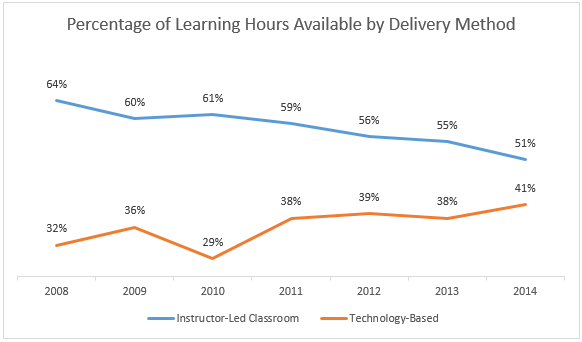ATD Blog
Is the Traditional Classroom Dying? Not Really.
Thu Mar 31 2016

Will talent development professionals eventually spend more time counting eyes on screens than they do bodies in chairs?

Looking at the graph of learning hours available by delivery method, that’s a natural question to ask. According to ATD’s 2015 State of the Industry report, the availability of instructor-led, classroom-based delivery fell in five of the six years between 2008 and 2014. It made up almost two-thirds of the learning hours available that year, but only half in 2014.
Meanwhile, the availability of technology-based training rose in four of those six years. In 2014, its share of learning hours available peaked at 41 percent. Clearly, the gap between traditional classroom-based hours and technology-based hours is narrowing.
Still, we should wait before writing any eulogies. Most learning professionals doubt traditional classroom learning will ever go extinct. After all, it makes up more training hours available than any other delivery method. Instead, they envision it incorporating technology to achieve a blended format that takes advantage of both tools’ strengths. According to ATD’s research report Instructional Design Now, 70 percent of talent development professionals think a blended approach will characterize learning by 2020.
This means that the traditional classroom is probably evolving instead of dying. Techniques like the flipped classroom, which requires students to first experience new material independently before using class time to reinforce and apply it, are growing in popularity. Today, only 25 percent of instructional designers use flipped classrooms, but an additional 41 percent have at least considered using them.
Without doubt, talent development professionals will have to adapt. Only 38 percent of learning departments consider themselves ready for 2020, and only 37 percent are preparing for changes in how employees learn, according to ATD’s research report Learners of the Future. Many talent development professionals have made careers of designing and delivering traditional classroom-based learning, and its endangerment could signal theirs too if they don’t prepare themselves.
The talent development professionals who do successfully react to this shift will enjoy great opportunities. By growing comfortable with a wider variety of tools for designing and delivering training, they can further advance what the industry is capable of doing.
